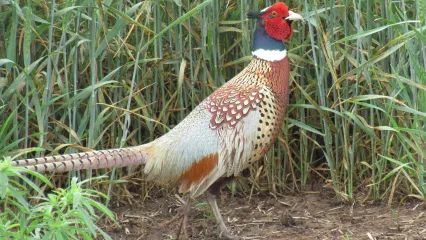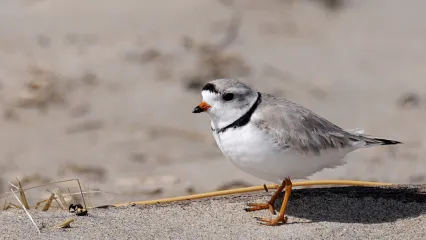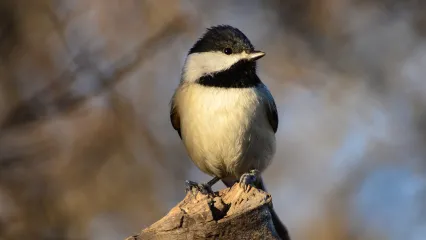
Description
The ring-necked pheasant is familiar to Oklahomans as this state's most colorful game bird. Pheasants are native to the Old World, mainly the Asian countries. The Chinese ring-necked pheasant, and hybrids with other races, were successfully introduced into the United States in the 1880s. Through natural and artificial reproduction and release, the birds have established and expanded their range.
Unlike some exotics, pheasants have thrived in this country with no ill effects on native wildlife. The pheasant has been most successful in areas where extensive cultivation and clean farming practices have made it difficult for other game to survive.
The typical cock pheasant has a blue-green head and distinctive white collar that gives the ring-necked pheasant its name. The rest of the cock's plumage is a varied pattern of iridescent colors: blue, green, red, burnished copper, yellow and white. The gold-hued tail feathers are quite long, painted and barred with black.
Grain, weed seed, wild fruits and berries make up the bulk of a pheasant's diet. Also included in the bird's fare are some insects and vegetative materials.
Size
The hen is smaller, averaging slightly more than 2 pounds compared to the cock's average 2.75 pounds. The hen's plumage is a mixture of brown, buff, and black. She also has pointed tail feathers, but they are not as long as the male's.
Habitat
When alarmed, the well-camouflaged hens generally choose to remain hidden. Cocks depend on escape by running or flying, their takeoff accompanied by a loud whirring of wings.
In fall and winter, pheasants are found in flocks that may consist of cocks, hens or both. Flocks break up in early spring as the cocks disperse and establish crowing territories. An inconspicuous patch of bare reddish skin around the cock's eyes begin to enlarge. By mating season, both sides of the head are covered with a brilliant red wattle.
Individual boundaries of crowing territories are not exact or permanent, but each cock regards a particular area as private property and defends it from trespass by other males. Hens are free to come and go at will and are courted by the males as they enter territories.
Life Cycle
Cocks harvested during hunting season do not affect the reproduction in a pheasant population because one male can easily manage a harem of a dozen or more females. Even when numbers of each sex are nearly equal, there are usually several hens to a cock, but some males remain single.
Crowing is the territorial call of the male. The call may attract hens and warn other males against trespassing. It is comprised of two syllables: a long note followed by a short one. The call is followed by six to eight wing claps that can be heard a short distance away. When the cock courts the hen, it struts in front of the hen with short rapid steps, displaying its colorful plumage.
Cock pheasants are not the least bit interested in family life. The hen hatches and rears the young alone. She builds a nest on the ground in fields of hay or grain, fencerows or other suitable cover. It is simply a slight hollow in the ground, scantily lined with vegetation. Up to 15 brownish-olive eggs are laid and incubated from 23 to 25 days.
Newly hatched pheasant chicks are active as soon as they are dry. The female leads them away from the nest, and they begin learning to find food. By the time they are two weeks old, they have some wing feathers and can fly short distances.
In five or six weeks the chicks are fully feathered. By late fall, the young pheasants have traded juvenile feathers for their first winter plumage and are nearly adult in appearance.
How To Observe
Oklahoma is on the southern fringe of the pheasant's range. The birds are found in western and northwestern counties, especially in the intensively farmed areas of the Panhandle.


